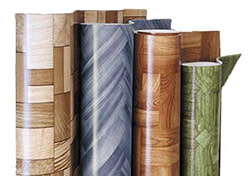 What is linoleum? This is a material obtained by applying a special resin-like compound to a fabric substrate. It can be natural - jute fibers are impregnated with oxidized linseed oil, to which pine resin and wood chips are added. But such linoleum is very expensive, so linoleum coated with artificial polymers, for example, polyvinyl chloride, is more common in everyday life. It is very practical, but at the same time it can quickly lose its attractiveness if you do not clean it from dust and dirt on time.
What is linoleum? This is a material obtained by applying a special resin-like compound to a fabric substrate. It can be natural - jute fibers are impregnated with oxidized linseed oil, to which pine resin and wood chips are added. But such linoleum is very expensive, so linoleum coated with artificial polymers, for example, polyvinyl chloride, is more common in everyday life. It is very practical, but at the same time it can quickly lose its attractiveness if you do not clean it from dust and dirt on time.
How to care for linoleum? First of all, after the flooring has been laid and the repair is completed, it is necessary to thoroughly wash it from building dust and cover it with a suitable composition to impart protective properties. In the future, to maintain and maintain a presentable appearance, as the contamination occurs, linoleum should be washed with warm water and mild detergents.
Linoleum care rules
The rules for caring for linoleum of any kind are almost the same, and consist of several mandatory points:
- Aggressive cleaning agents can not be used when cleaning linoleum floors, as they can ruin the coating;
- Caustic soda and other alkalis can corrode the base of linoleum;
- Hot water can make the surface of linoleum matte;
- If substances containing coloring pigments are spilled onto the floor, they must be removed immediately to avoid absorption of the pigments in the surface layer and the appearance of colored heels on linoleum.
However, natural linoleum and the material obtained with the use of synthetic polymers have differences that must be taken into account when leaving, if you want the floors to retain their shine and attractive appearance for a long time:
- Natural. So that this strong and durable material does not lose its appearance for as long as possible, after laying it is thoroughly cleaned of construction waste using dry and wet cleaning. Then, letting it dry completely, they put mastic protective compounds, which are carefully polished. Depending on how "passage" the room is, the floor is reprocessed with mastic two to four times a year, updating the protective coating.
- Artificial. Polymeric substances, in particular polyvinyl chloride (PVC), are used as substitutes for thickened linseed oil with fillers from natural components in the production of linoleum. This significantly reduces the cost of production and, accordingly, the product. PVC coating can be homogeneous - and then it is quite thick, and heterogeneous - with a thin top decorative layer. The latter needs special care, since a thin layer is easily broken and loses its appearance. Cleaning of such floors with the use of solvents (acetone, white spirit, kerosene) is prohibited.
Removing stains when cleaning linoleum
In the event that you did not notice pollution in time, and a stain has formed on linoleum, it should be removed taking into account the specifics:
- Coffee, dyes from food: drip a few drops of kerosene or gasoline on a clean, dry cloth and gently rub the stain.If the dye got on natural linoleum, it can be gently rubbed with a piece of “zero” skin (with the smallest “grain” size, then wiped with a damp cloth, allowed to dry and grease with linseed oil;
- Iodine: The iodine stains may gradually disappear themselves, but it is better to try to remove them by pouring a little soda on a damp cloth and gently rubbing it. After this cleaning, the linoleum should be washed well and rubbed with polish.
- Zelenka: Apply a little camphor alcohol to the fleece and rub the stain. Change the cotton wool as it becomes soiled.
- Mold, rust: linoleum is cleaned of these contaminants using hydrogen peroxide diluted with water in a ratio of 1 to 10. You can also use bleach to wash the laundry, also diluting it in water. After that, it is good to wipe the surface with lemon juice.
- Fat: grease is washed off with a solution of mild detergents, previously wet with a paper towel.
Linoleum cleaning: materials, tools, work procedures
To care for linoleum flooring, you will need the following materials:
- A mild detergent that does not contain acids, alkalis or abrasives;
- Warm water;
- Protective coating (polish) for finishing care.

Of instruments To clean linoleum you need:
- Bucket;
- Floor brush,
- Floor rag;
- Vacuum cleaner;
- Napkins for cleaning.
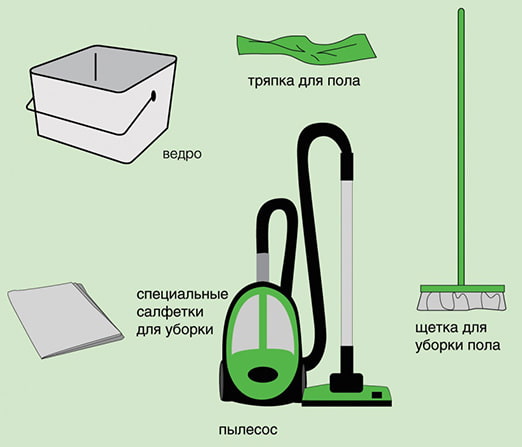
Work order
Cleaning can be divided into three main stages. Let's consider them one by one.
1
Dirt cleaning
Cleaning begins with a dry cleaning of linoleum, which removes debris and dust. This is done with a brush and vacuum cleaner. After that, you need to inspect the floors for stains. If they are, withdraw using suitable means.

After that, you can proceed to wet cleaning.
- Pour warm water into a bucket, add a mild detergent, stir;
- Wet a rag and squeeze it well;
- Wipe linoleum with a damp cloth;
- After wet cleaning, wipe linoleum with a dry cloth.
Important: Do not add ammonia, soda to water, or use various solvents to clean stains - they can impair the appearance and performance of linoleum.

2
Polishing
To linoleum shone, it is polished with special means. Select the polish according to the material of which the flooring is made.

3
Protection
Preventive measures are the best way to preserve flooring for years to come. Linoleum is subjected to both mechanical action and the action of various, often aggressive environments. Therefore, preventive measures can also be divided into two groups:
- Mechanical: Furniture legs should be smooth so as not to scratch the linoleum. Make felt padding on them, or put on special covers. An ordinary hard mat near the front door, or a lattice mat, will help to clean the shoes of street sand, which, when brought into the apartment, acts on linoleum as an abrasive, depriving it of its luster and attractiveness.
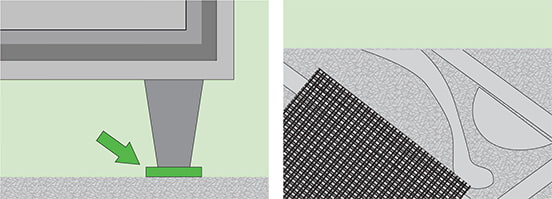
- Chemical: At the finishing stage of cleaning linoleum, a protective layer can be applied to the floor. It can be a variety of polishing compounds and emulsions. They create a protective film on the treated surface that insulates the material from external influences. The protective layer will reduce the adhesion properties of linoleum, it will be less dirty and absorb dirt. This facilitates the care of linoleum, increases its resistance to abrasion and scratches, gives water-repellent properties, significantly extends the service life.

Tip: To extend the life of the flooring, observe its operating conditions. Avoid negative factors that adversely affect linoleum. These include:
- Ultraviolet (direct rays of the sun);
- Mold and fungi (formed when water gets into the joints of canvases);
- Temperature differences;
- Open fire;
- Stitching and cutting surfaces.

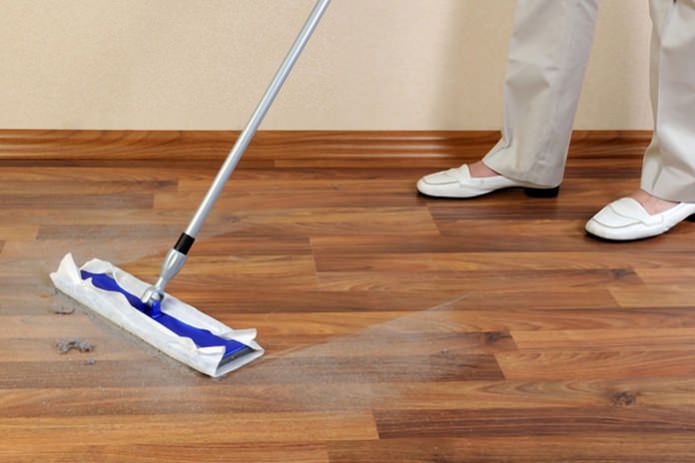
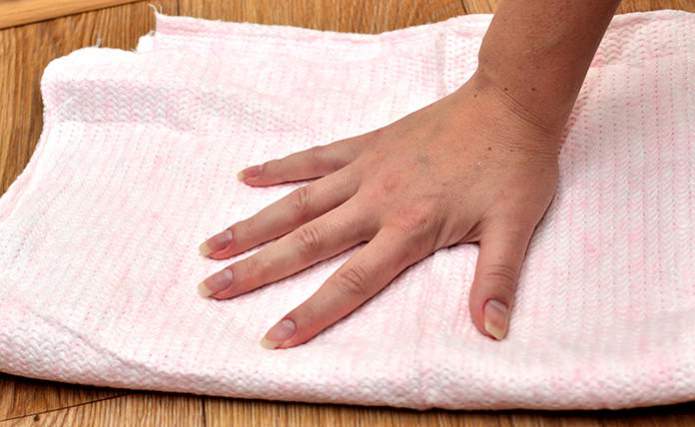

 Top 10 Trends in Interior Design 2020
Top 10 Trends in Interior Design 2020 Rating of cheap TVs with Smart-TV
Rating of cheap TVs with Smart-TV New Year's LED garlands on AliExpress - we disassemble while it's hot, so that the house is bright
New Year's LED garlands on AliExpress - we disassemble while it's hot, so that the house is bright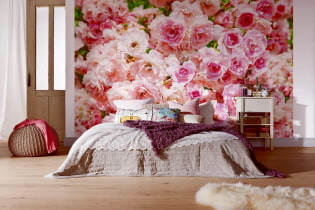 Wall mural with flowers in the interior: living wall decor in your apartment
Wall mural with flowers in the interior: living wall decor in your apartment Gray sofa in the interior: views, photos, design, combination with wallpaper, curtains, decor
Gray sofa in the interior: views, photos, design, combination with wallpaper, curtains, decor Interior in peach tones: meaning, combination, choice of finishes, furniture, curtains and decor
Interior in peach tones: meaning, combination, choice of finishes, furniture, curtains and decor